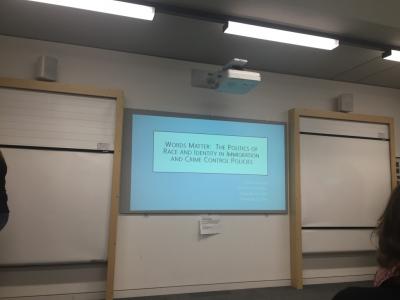Border Criminology in the Trump Era – Words Matter Now, More than Ever Before
Posted:
Time to read:
Post by Maayan Ravid, DPhil Candidate, Centre for Criminology, University of Oxford. Maayan’s academic studies follow over a decade of work on social justice issues in Israel, focused on migration and minority rights. She has been involved in grassroots organizing and NGO activism alongside migrant communities in Israel from Ethiopia, Sudan and Eritrea, as well as the Israeli resident community in South Tel Aviv. Her current research focuses on the detention of African Asylum Seekers in Israel.
November 24th 2016. Two weeks had passed since the results of the United States election were declared, a dramatic moment in history that many are still struggling to comprehend. Responses to the elections have been varied and contrasting – mourning, anger, fear, shock and dismay for some; joy and victorious jubilation, for others. While some feel they no longer recognize their own country, or feel safe in it, others believe they are re-claiming control of their nation. Regardless of any individual’s political preferences, the election undoubtedly drew on debates about migration that were characterized by racialized language. Divisive rhetoric was employed, particularly by the President-elect, in his focus on people migrating from Mexico and Central and South America; as well as Muslims residing in the United States.

Vázquez discussed how since 2002, and especially under the Obama administration, there were increasing connections between levels of crime and migration enforcement in the US. As a consequence, by 2015, over 400,000 people were removed annually, most of whom defined as ‘criminal aliens’, while an additional 400,000 persons were held in immigration detention (twice the amount of those housed in the Federal Bureau of Prisons). Given that a vast majority of those detained and removed are people of color, the concept of the criminal alien is thus racialized and constructed as a danger to be removed from the territory.
Vázquez’s analysis challenged the dangerousness of those who are removed and whether they do pose a threat to American communities. She pointed to the paradox that despite the criminality attributed to this population, 47.7% of removed persons have no convictions at all. She also presented data and studies that show how the large part of undocumented migrants in the US have resided there for more than 10 years, are employed and have been known to have a positive influence on their urban environments. Additional data showed how different forms of immigration enforcement, such as detention and deportation, add up to cost approximately 18 billion dollars per year.
By presenting this data Vázquez directed our attention to the discrepancy between increased punitive measures and resources directed at migrants, the characteristics of the phenomena, and the population itself. She juxtaposed the increasingly harsh treatment of this population, the tremendous efforts and resources devoted to their exclusion and removal, with the actual stagnation in numbers of new arrivals and largely non-criminal community attributes. Lacking a logical correlation between immigration and crime, the continued punitiveness imposed upon Latino migrants and increasingly stringent enforcement, migration control emerges as disproportionately applied to racialized groups.
Despite these statistics, why does race continue to be a defining component in migration control? Vázquez ventured into the realms of psychology and human behavior, drawing on theories of social stratification, to make sense of these trends. She argued that human beings are socialized to classify people and create boundaries based on social distinctions. We delineate those who belong to our group, and those who do not. People hold on to categories of belonging in very strong and emotional ways, especially when under stress or perceived threat. Political rhetoric often targets these emotional urges, tapping into people’s fears and anxieties while legal institutions help shape and reinforce these stratifications.

Vázquez provided examples from political speech, media and propaganda campaigns, to illustrate the ways in which rhetoric is used to frame certain groups as less than human. She recounted the commonplace descriptions of Mexicans as drug dealers, criminals, and rapists during the 2016 US elections, as well as historical examples dating back to the 1980s of animalistic, criminalizing and demonizing adjectives used to describe migrants. Through these examples she argued that migrant communities are stripped of their humanity, and their harsh treatment is rationalized.
Vázquez cited recent research indicating that Arabs and Muslims are the group most dehumanized in the US today, followed by Latino immigrants. She noted however that African Americans and Mexican Americans, experience explicit and implicit degrees of dehumanization as well. Considering psychological processes of dehumanization, alongside political rhetoric that invokes social distancing from migrants and people of color, as well as a legal system that enables their physical removal, it seems that dangerous times lie ahead for these groups. While the nation’s laws articulate equal rights and treatment for all, it appears that political discourse of difference and public opinion speak louder.
Yolanda Vázquez’s talk was aptly titled WORDS MATTER and she compellingly showed how race and immigration enforcement are intimately connected, and that social stratification fueled by political rhetoric serve to exacerbate racialized state practice. This is perhaps a grim diagnosis for border criminologists, particularly if the President-elect continues to choose inflammatory and divisive words to describe migrants, Muslims and people of color. On the other hand, it also provides an opportunity for border scholars and activists to remain vigilant as we research, to call out concerning trends as we see them, and to choose strong words in response.
Any comments about this post? Get in touch with us! Send us an email, or post a comment here or on Facebook. You can also tweet us.
__________
How to cite this blog post (Harvard style)
Ravid, M. (2017) Border Criminology in the Trump Era – Words Matter Now, More than Ever Before. Available at: https://www.law.ox.ac.uk/research-subject-groups/centre-criminology/centreborder-criminologies/blog/2017/02/border (Accessed [date]).
Share:








